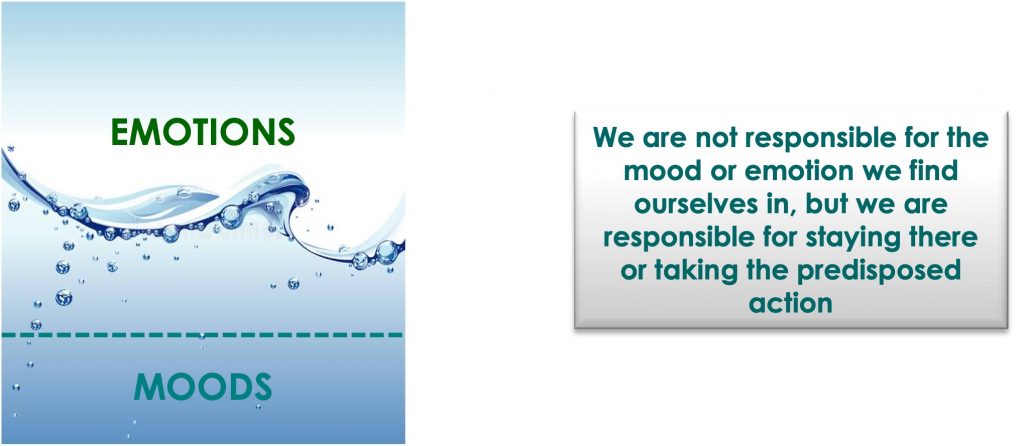
If moods relate to our general sense of affect, emotions are related to specific situations in which we find ourselves. As with moods, emotions are related to predictions, interoception, affect and our concerns. The key difference lies in the immediacy of the situation.
The immediacy of a situation often creates breakdowns and the need to rapidly resolve a prediction error. Breakdowns require an immediate call to action involving rapid shifts in our body’s resources. Such rapid shifts can greatly impact both aspects of affect as our predictions seek an immediate solution to what is happening. The higher the levels of valence and arousal, the stronger the emotion. The immediacy of the situation can also relate to our expectations coming more sharply into focus. For example, if we have been anxious about an impending medical test result, then this anxiety will be feeding our predictions and fuelling our interpretations of bad outcomes heightening our predictions for more action and stretching our body budget further.
So, the key difference between a mood and an emotion is in the immediacy of the breakdown and a higher level of affect.
It is important to recognise that moods and emotions are not things themselves but distinctions we make to explain the sensations from our interoceptive network. We feel angry because of physical sensations that already exist. Moods and emotions happen after our predictions have created simulations that have primed our body for action.
Ultimately our emotional life can be seen as an emotional background in the form of a mood with emotional crests and troughs in response to the breakdowns we have in life. In other words, our moods not only reflect our current predisposition for action, they are also a predisposition for the interpretation of our emotions.
Different moods impact on how we observe the world and what is possible. Our breakdowns appear to us when our flow of life is disrupted and what is possible, and our expectations are called into question. Hence an event happening in different moods, happens in different contexts – spaces of possibilities – and may well evoke different breakdowns and emotional responses. For example, if I wake up in the morning in an unpleasant mood, then stubbing my toe on the end of the bed may well evoke a much different emotional response than if the same thing happened when I wake up in a more upbeat mood.
Even though I have indicated that moods and emotions create predispositions, this is not entirely accurate. What has happened in our body because of our predictions is priming us for action and the resultant sensations we call our moods and emotions. They in turn feedback into our predictions adding to the context in which we make meaning and affecting our predispositions. Our moods and emotions are a significant part of how we create meaning.
Generally, we can say the following about moods and emotions:
- A mood reflects our current general stance – constructive or defensive – to the world and how we expect things to occur with particular reference to the what we believe we can or cannot and the uncertainty of the future. We generally only notice our mood when we focus on how we are feeling;
- Emotions reflect our current predispositions for action as they relate to what we expect to happen next. Our emotions are often more obvious to us as how we feel is a dominant part of our experience in that moment;
- Moods and emotions are both internal experience feedback loops indicating our current predispositions. As such they feed into our interpretation and predictions;
- Moods are ever-present and like the deep currents of a river whereas emotions are the ripples on the surface;
- Our mood is a predisposition for our emotions;
- Moods and emotions indicate a predisposition for action and establish a space of possibilities;
- Emotions that hang around for long enough can become a mood;
- In our interactions with others, we tend to develop similar ways of interpreting what is going on with a resultant shift in our body’s resources. This leads to the conclusion Moods and emotions are contagious; and
- Our predispositions are born of patterns of predictions from our experience meaning that designing and creating new patterns of prediction can lead us into new patterns of moods and emotions in life
A key theme of this work is that to design our future ways of being requires that we understand our way of being in language. The better our distinctions of moods and emotions, the better our capacity to intervene in our predispositions to generate new ones. We can seek to design our moods and manage our emotions through language.
To do this we need granular distinctions of our emotional life in order to appreciate our feelings as more than good or bad. To do so, we now turn our attention to creating some distinctions of moods and emotions, beginning with moods.
